How to make use of QR codes with your iPad (teachers & students!)

How teachers can show student progress during lesson observations
It is incredible to think of the number of lessons that I have observed in the past decade. I have entered classrooms as an inspector, a reviewer, a coach in primary, special and secondary schools from Mumbai to New York, Barcelona to Birmingham, Jeddah to Jarrow. And the recurring question that UK teachers ask me is the one above – how can they show visible improvement during lesson observations? The Ofsted inspection framework places a strong emphasis on key skills in schools. The same emphasis is found in the new Teachers’ Standards. TeachersMedia has just produced a short series of 20-minute programmes filmed in classrooms in a number of schools including Slough and Eton College in Berkshire. An exciting climate for learning One key aspect which shines through in the films is that in exciting classrooms there is that judicious balance of the fun and fundamentals of learning. Inspiring and vibrant teaching Pupils in the films are infected by the enthusiasms of their teachers.
Uri Treisman’s Magnificent Speech On Equity, Race, And The Opportunity To Learn
On April 19, 2013, the third day of NCTM's annual meeting in Denver, Uri Treisman gave a forty-minute address on equity that Zal Usiskin, director of the University of Chicago's School Mathematics Project, called the greatest talk he'd ever heard at the conference in any year. Stanford math professor Keith Devlin would later call it our "I have a dream" speech. At least one participant left in tears. I've personally seen it three times. I got the video feed from NCTM and the slides from Treisman. I then spent some time stitching the two together, resulting in this video . You should watch it . If you're interested in equity, you should watch it. If none of those conditions apply to you, well, I can't imagine the series of misclicks that brought you to my blog. Here's a fair enough summary from Treisman himself: There are two factors that shape inequality in this country and educational achievement inequality. That was his destination and the talk took only three stops along the way:
How A Daring Teacher Promotes Creativity
Be a daring teacher! Let every student experience the joy of creativity. Bring a breath of fresh air into your teaching. Teachers are in the know. When creativity takes center stage, our performance and that of our students is awesome. For teachers the rewards are just as significant. No strict curriculum, no subject, no lack of materials, no limitations on time can stand in the way of creativity. Promote creativity every chance you get! An appealing environment is conducive to learning and equally as appealing is a lesson involving every single student and promoting collaboration. If only we could be as spontaneous as our students. Become well acquainted with your students. Students will take to a project if it is purposeful not to mention if they are allowed to be as creative as they want. Join students and learn alongside them. Pulling a rabbit out of a hat every day is not easy but not every day calls for the same class routine.
Pragmatic Education | Cutting-edge ideas for system reform: What works is what's best
Becoming A Better Teacher: Teachers Doing It For Themselves
“Every teacher needs to improve, not because they are not good enough, but because they can be even better.” Dylan Wiliam Every teacher wants to get better. I use Dylan Wiliam’s quotation over and over unashamedly because I think it strikes a truth that all teachers and school leaders must embrace. I used it to begin my #TMClevedon seminar on ‘becoming a better teacher‘. We all know and understand the pivotal impact of teacher quality for our students and surely we all want to be better. Of course, many teachers are not improving. After the whirlwind of feedback and the perilously steep learning curves of our first two years as teachers the impact of experience dulls. The Problem with Continuous Professional Development As the line goes, no man is an island. Like waiting for some course that will deliver pedagogical manna from heaven, we too often look in the wrong place for answers. The Answer: ‘Deliberate Practice’ So what is it? What are the Barriers to Improvement? Reflect to Improve
Related:
Related:



